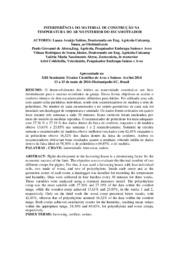Interferência do material de construção na temperatura do ar no interior do escamoteador.
Interferência do material de construção na temperatura do ar no interior do escamoteador.
Author(s): SABINO, L. A.; ABREU, P. G. de; SOUSA JÚNIOR, V. R. de; ABREU, V. M. N.; COLDEBELLA, A.
Summary: O desenvolvimento dos leitões na maternidade constitui-se um fator determinante para o sucesso econômico na granja. Dessa forma, objetivou-se avaliar o conforto térmico de dois escamoteadores diferentes para leitões. Foi utilizada uma sala com quatro celas parideiras individual, sendo dois escamoteadores de madeira e dois de polietileno. No interior de cada escamoteador e no centro geométrico de cada sala foi instalado um datalogger de temperatura e umidade. Os dados foram coletados em quatro lotes durante três semanas a cada 30 minutos. Essas variáveis foram analisadas, por meio do modelo de medidas repetidas. O escamoteador de polietileno foi mais adequado com 27,36 % e 27,19 % dos dados dentro da faixa de conforto, enquanto o de madeira obteve 13,61% e 23,85% nas semanas 1 e 2 respectivamente. Somente na terceira semana o escamoteador de madeira obteve melhores resultados com 42,45% enquanto o de polietileno obteve 16,52% dos dados dentro da faixa de conforto. Ambos os escamoteadores obtiveram bons resultados quanto a umidade, obtendo média de dados dentro da faixa ideal de 58,30% o de polietileno e 69,85%, o de madeira. Piglet development in the farrowing house is a determining factor for the economic success the farm. The objective was to evaluate the thermal comfort of two different creeps for piglets. For this, it was used a farrowing house with four individual cells, twomade of wood, and two ofpolyethylene. Inside each creep and at the geometric center of each room , a datalogger was installed for recording the temperature and humidity. Data were collected in four batches every 30 minutes for three weeks. These variables were analyzed using a repeated measures model. The polyethylene creep was the most suitable with 27.36 % and 27.19% of the data within the comfort range, while the wooden creep achieved 13.61 % and 23.85% , in the weeks 1 and 2, respectively. Only on the third week the wood creep presented better results, with 42.45%, whereas that of polyethylene attained 16.52% of the data within the comfort rang. Both creeps achieved satisfactory results for the humidity, reaching mean values within the appropriate range, 58.30% and 69.85%, for polyethylene and wood creeps, respectively.
Publication year: 2014
Types of publication: Paper in annals and proceedings
Unit: Embrapa Swine & Poultry
Keywords: Arrowing, Edificação, Swines, Welfare
Observation
Some of Embrapa's publications are published as ePub files. To read them, use or download one of the following free software options to your computer or mobile device. Android: Google Play Books; IOS: iBooks; Windows and Linux: Calibre.
Access other publications
Access the Agricultural Research Database (BDPA) to consult Embrapa's full library collection and records.
Visit Embrapa Bookstore to purchase books and other publications sold by Embrapa.

